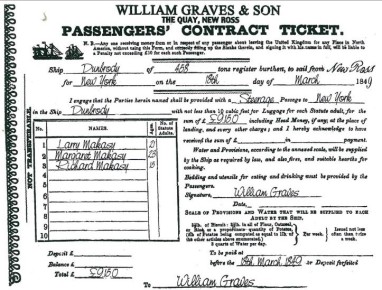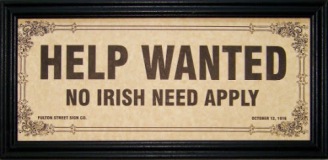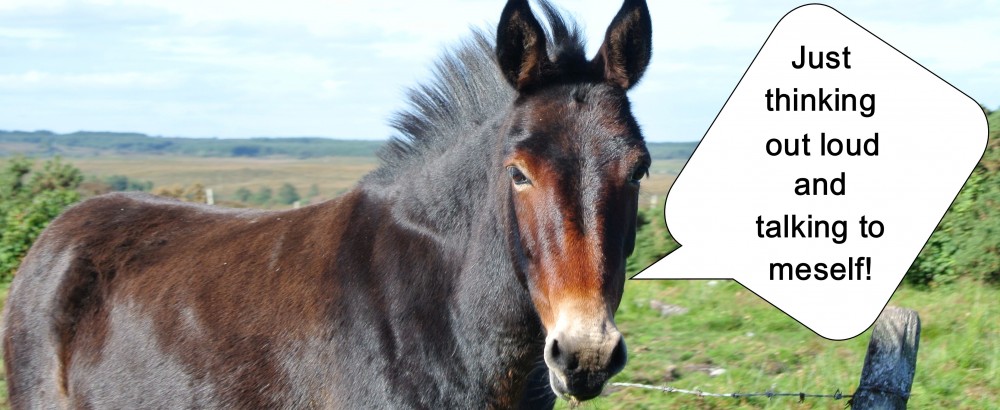In a recent conversation regarding the present migrant crisis in Europe, and the current fear mongering against Muslims, I began to see a similarity between the mass exodus of the Irish due to the Great Hunger in the years after 1845. Is there anything we can learn from a comparison?
Marginalisation of immigrants is a pattern that repeats throughout history. Europe and now America are continuing that pattern. Fear, always the main ingredient of marginalisation, now at an all-time high. “Who are we letting in?” being the question most people ask.
There are some similarities between the current European migrant crisis, our US terrorist situation and the Irish who managed to survive the treacherous trans-Atlantic ocean crossing in the years after 1845.
I’ve written here before about coffin ships and the horrible conditions Irish emigrants endured. Not every ship was a “coffin ship.” There were a few ships, such as the Dunbrody, and the Jeanie Johnston that made the journey with minimal or no loss of life. Most quarantined ships during the Great Hunger years brought emigrants to the Canadian port of Grosse Île in Quebec.
Grosse Ile quarantined the sick, controlled the spread of disease and the flow of immigrants into Canada and the US.
If Irish immigrants did survive the journey on the coffin ship, and many did not, it was the first in a series of hurdles that they would need to clear.

(Picture via The Dunbrody Irish Emigrant Experience)
Approved for entry into their new homelands, the migrants did not look healthy compared to the natives. The skeletal immigrants were looked on as sub-human and diseased. They’d saved what they could for the long journey in a time when food and money were scarce. What little money they did have was put aside for passage fares on coffin ships, not food.
It was not long before “No-Irish Need Apply” signs began to appear in shop windows and lodging houses throughout the US.

(Picture via Dennis MA Public Library)
The Irish, a starving people, did not fit in and were treated poorly because of it. They looked “sick.” Why was there a shortage of food in Ireland during the years 1845-1852? Ireland is a farming country. Lots of good farmland for growing crops and grazing livestock, so why not eat what you grow?
Christine Kinealy in History Ireland magazine says, “Almost 4,000 vessels carried food from Ireland to the ports of Bristol, Glasgow, Liverpool and London during 1847,…The food was shipped under military guard from the most famine-stricken parts of Ireland;… A wide variety of commodities left Ireland during 1847, including peas, beans, onions, rabbits, salmon, oysters, herring, lard, honey, tongues, animal skins, rags, shoes, soap, glue and seed.”
Though popular opinion at the time would have alleged the Irish to be sick, lazy and half-witted, nothing could have been further from the truth. The Irish worked hard to assimilate into a new culture. Were all immigrants perfectly behaved? Of course not. But the larger population of Irish did work hard, making a respectable life in their new homelands.
Here’s a few notable Irish-Americans who made a difference. There are a few gangsters in there too, I won’t revise history, but the positive immigrants and their lagacies by far out weigh the negative ones.
The Irish were not the only immigrants to go through a rough transition period. Italian, Chinese, German, Jewish and Mexican immigrants have all endured growing pains in the US. In 1875 the US government began to regulate immigration and only a few years later the US banned immigrants from certain countries. Sometimes ethnic groups such as African-Americans and Japanese, already citizens and living in the US, were marginalized and discredited as well as being treated like third class citizens.
I am not against increased security checks for immigrants. I myself was interviewed, fingerprinted, TB tested, lung x-rayed and AIDS tested, yes I was. And so was every other Donnelly Visa Lottery winner. Determined to get a visa for the US, I was willing to jump through every hoop presented in order to get my legal visa, eventually a Green Card, and then citizenship.

“Give me your tired, your poor,
Your huddled masses yearning to breathe free,
The wretched refuse of your teeming shore.
Send these, the homeless, tempest-tossed, to me:
I lift my lamp beside the golden door.”
(Picture via New York City Wallpapers)
In fact, I have nothing against comfortable and humane quarantine stations either, the cost of which should be burdened by all countries of processed immigrants. If we are taking in the tired, poor and huddled masses, share that burden with us.
There are a lot of ways to do background checks and prevent undesirable immigrants from entering the US presently. Detaining immigrants until they have been fingerprinted and have background checks and deporting the ones who refuse is a good start.
Gun control is another excellent step in the right direction to protect us from terrorists at home and abroad. Despite what Donald Trump is saying, not every Muslim is a terrorist. Anti-Muslim sentiment is nothing more than Donald Trump’s scare-mongering for votes. Hitler did it and Oliver Cromwell did as well.
History. Sometimes we can learn from it, more often than not we learn nothing more than we are doomed to repeat it.

